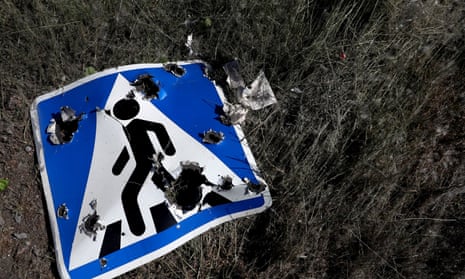Any way you count it, the figures are stark: Ukrainian casualties are running at a rate of somewhere between 6oo and 1,000 a day. One presidential adviser, Oleksiy Arestovych, told the Guardian this week it was 150 killed and 800 wounded daily; another, Mykhaylo Podolyak, told the BBC that 100 to 200 Ukrainian troops a day were being killed.
It represents an extraordinary loss of human life and capacity for the defenders, embroiled in a defence of the eastern city of Sievierodonetsk that this week turned into a losing battle. Yet the city was also arguably a place that Ukraine could have retreated from to the more defensible Lysychansk, across the Siverski Donets River, the sort of defensive situation that Ukraine has fared far better in.
The sheer number – more than 20,000 casualties a month – raises questions about what state Ukraine’s army will be in if the war drags on into the autumn. The same is true for the Russians too, of course. But the invaders already control large chunks of Ukraine, and they can pause the fighting with the territorial upper hand.
Consider the figures in context. Ukraine’s army was 125,000 strong, according to the International Institute for Strategic Studies, and there were 102,000 national and border guards in addition. Analysts’ crude estimates suggest that since the start of the war the total could have doubled to an impressive 500,000.
Kyiv’s forces are far from a point of collapse. But several months of high casualties will erode its fighting strength significantly, even allowing for some of the wounded to recover. Meanwhile, Ukraine’s forces are already being pushed back in a Donbas artillery bombardment so intense it is likely to have a shell-shock impact on many of those who survive it. Morale is certainly an issue for the Russians, but there are now reports of desertions from the Ukrainian side too.
So pressing is the situation that foreigners with combat experience who pass the tests to join the international legion could be on the frontline in less than a month after crossing the Ukrainian border. But again, the high level of casualties now being openly discussed may act as a deterrent to recruits in the future.
Western officials prefer not to discuss the impact of the war on the defenders, instead highlighting the problems for the Russians in their briefings. This week, one of those officials said their estimate was that the invaders had lost “15,000 to 20,000 dead”, out of an invasion force that was 150,000 or more. Yet despite this, Moscow’s army has still not lost its offensive capability.
But they chose not to provide similar estimates for Ukraine, which can create a lopsided impression that the Russians are faring worse. In fact, with an artillery overmatch of 10 or 15 to one, according to the Ukrainians, it may well be that the invaders’ casualty rate is far lower at the moment, because they are able to deal death from a greater distance to defenders who cannot see them.
Ammunition is certainly running short on the Ukrainian side, again by their own admission. Vadym Skibitsky, the deputy head of Ukraine’s military intelligence, has said Ukraine is using 5,000 to 6,000 artillery rounds a day, and has “almost used up” its stockpile of Soviet 152mm standard shells. It is now relying on Nato-standard 155mm howitzers; it is unclear how many of these it has.
Commanders have told the Guardian that Ukraine struggles for some basic equipment such as encrypted radios (where mobile phones work, it is not uncommon to rely on the secure Signal app instead) or advanced sights and optics of the types commonly used by western militaries.
Ukraine is not short on bravery and determination. Western support is still in place, as shown by the UK announcement to supply a handful of – perhaps three – multiple rocket launchers this week, even if Kyiv said almost immediately it wanted many times more. But it is Russia’s forces that have found a way to advance in the Donbas, raising the question of whether the three-month war is at another turning point.
